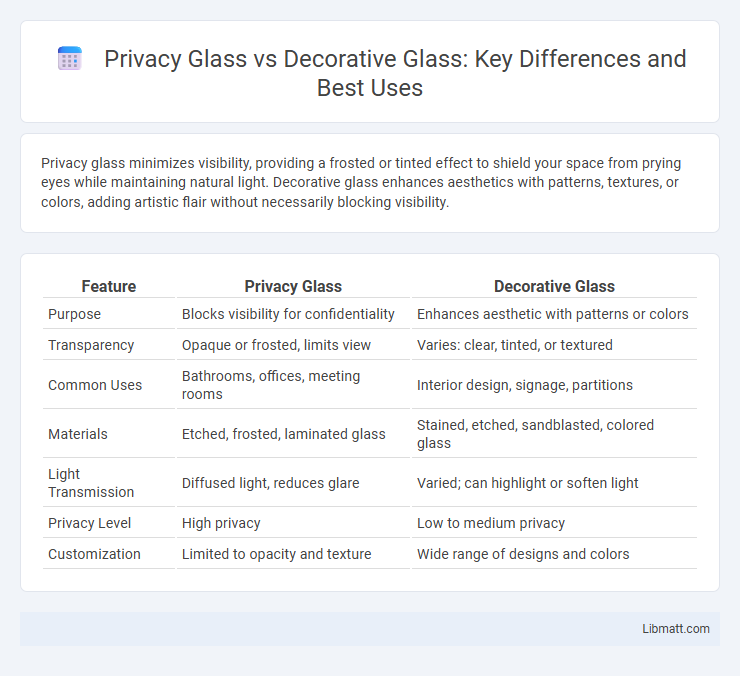Privacy glass minimizes visibility, providing a frosted or tinted effect to shield your space from prying eyes while maintaining natural light. Decorative glass enhances aesthetics with patterns, textures, or colors, adding artistic flair without necessarily blocking visibility.
Table of Comparison
| Feature | Privacy Glass | Decorative Glass |
|---|---|---|
| Purpose | Blocks visibility for confidentiality | Enhances aesthetic with patterns or colors |
| Transparency | Opaque or frosted, limits view | Varies: clear, tinted, or textured |
| Common Uses | Bathrooms, offices, meeting rooms | Interior design, signage, partitions |
| Materials | Etched, frosted, laminated glass | Stained, etched, sandblasted, colored glass |
| Light Transmission | Diffused light, reduces glare | Varied; can highlight or soften light |
| Privacy Level | High privacy | Low to medium privacy |
| Customization | Limited to opacity and texture | Wide range of designs and colors |
Introduction to Privacy Glass and Decorative Glass
Privacy glass uses special coatings or tinted layers to obscure visibility, enhancing confidentiality in residential or commercial spaces. Decorative glass incorporates patterns, textures, or colors designed to enhance aesthetic appeal while allowing light to pass through. Your choice depends on whether you prioritize seclusion or visual design in your space.
Key Differences Between Privacy Glass and Decorative Glass
Privacy glass is designed primarily to enhance confidentiality by obscuring visibility through tinted or frosted finishes, making it ideal for reducing glare and ensuring discretion in spaces like offices or vehicles. Decorative glass, on the other hand, emphasizes aesthetic appeal with a variety of patterns, textures, and colors that enhance interior design without necessarily blocking visibility. Your choice depends on whether your priority is functional privacy or visual enhancement, as privacy glass prioritizes obscurity while decorative glass focuses on artistic expression.
Materials and Manufacturing Processes
Privacy glass typically uses tinted or frosted treatments applied to tempered or laminated glass, enhancing opacity to block visibility while maintaining light transmission. Decorative glass involves diverse materials such as stained glass, textured glass, or etched glass, created through artistic techniques like sandblasting, acid etching, or incorporating colored enamels during the glass melting process. Manufacturing privacy glass prioritizes uniform opacity and durability, whereas decorative glass emphasizes aesthetic patterns and surface finishes through specialized craftsmanship.
Privacy Features: Functionality Comparison
Privacy glass offers advanced light diffusion and opacity that blocks visibility, ensuring complete privacy in both residential and commercial settings. Decorative glass provides varying levels of translucency and aesthetic patterns, balancing partial privacy with design elements but less effective at fully obstructing views. Your choice depends on whether functionality for maximum privacy or a blend of privacy and style is the priority.
Design Options and Aesthetic Appeal
Privacy glass offers a sleek, modern aesthetic with options like frosted, tinted, or etched finishes that enhance privacy while maintaining natural light flow. Decorative glass provides a wider range of design possibilities, including stained, beveled, or textured patterns that serve both functional and artistic purposes. Both types contribute distinct visual appeal; privacy glass emphasizes subtle elegance and discretion, whereas decorative glass highlights bold, customized design statements.
Common Residential and Commercial Applications
Privacy glass is widely used in residential bathrooms, conference rooms, and office partitions to prevent visibility while allowing natural light, enhancing both comfort and functionality. Decorative glass finds common applications in residential settings such as cabinet doors, room dividers, and windows to add aesthetic appeal and texture, as well as in commercial spaces like hotel lobbies and retail stores for branding and ambiance. Both glass types serve distinct purposes; privacy glass prioritizes obscuring vision for confidentiality, whereas decorative glass emphasizes design enhancement.
Installation Methods and Considerations
Privacy glass typically requires professional installation due to its specialized tinting or frosted finish, ensuring proper adhesion and uniform appearance, whereas decorative glass offers more flexibility, often allowing for DIY installation with adhesives or mounting hardware. Considerations for privacy glass include ensuring the glass tint or film is compatible with your window frames and climate to prevent bubbling or peeling. Your choice may also depend on structural support requirements, as decorative glass panels can be heavier and need reinforced fixtures for safe and secure installation.
Maintenance and Durability Factors
Privacy glass typically features specialized coatings or films that resist scratches and smudges, making it easier to maintain and clean compared to some decorative glass types, which may have intricate patterns or textures that trap dust and require gentle care. Durability of privacy glass often surpasses decorative glass as it is designed for functional use in vehicles or offices, with resistance to fading and damage from UV exposure. Decorative glass, while aesthetically versatile, may be more prone to chipping or scratching due to surface treatments or embedded designs, necessitating careful handling to preserve its appearance.
Cost Comparison: Privacy Glass vs Decorative Glass
Privacy glass typically costs between $5 and $10 per square foot, offering functional benefits such as light diffusion and obscuring visibility for added privacy. Decorative glass varies widely in price, ranging from $10 to $50 per square foot depending on design complexity, materials, and customization options. Despite higher costs, decorative glass adds aesthetic value and can serve as a focal point, whereas privacy glass prioritizes practicality and cost-efficiency.
Which Option is Right for Your Space?
Privacy glass offers superior opacity, making it ideal for spaces requiring confidentiality such as offices or bathrooms, while decorative glass enhances aesthetic appeal with patterns, colors, or textures suitable for living areas and creative designs. Consider the level of light transmission needed; privacy glass limits visibility without sacrificing natural light, whereas decorative glass balances visual interest with varying degrees of translucency. Selecting between privacy and decorative glass depends on the functional needs of your space and the desired ambiance, ensuring both security and style are achieved.
privacy glass vs decorative glass Infographic

 libmatt.com
libmatt.com